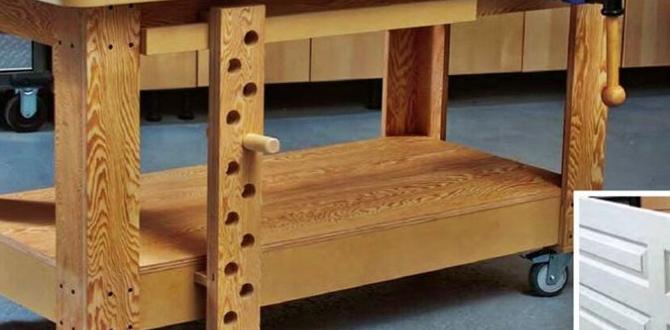Quick Summary
Mastering using a nailer in vertical work is key for solid, stable projects. Follow these expert tips on tool selection, technique, and safety to securely fasten materials against walls or uprights, ensuring professional results whether you’re framing, installing trim, or building a fence. Get your vertical nailing right every time!
Hey there, DIYers! Jack Shaffer here from Nailerguy. Ever find yourself wrestling with a nail gun when the work goes up and down instead of sideways? You’re not alone! Getting a nailer to drive fasteners effectively and safely when you’re working on vertical surfaces – like walls, fence posts, or even stairs – can feel a little tricky at first. It’s a common challenge, but with the right approach, it becomes a snap.
Don’t let those upright projects get you down. In this guide, I’m going to walk you through everything you need to know. We’ll cover choosing the right nailer, mastering the technique, and, most importantly, staying safe on the job. Ready to nail those vertical tasks with confidence? Let’s dive in!
Table of Contents
Why Vertical Nailing Can Be a Puzzle
Working with a nailer on a horizontal surface, like a workbench, often feels natural. Gravity is your friend, helping to keep the workpiece stable and the nailer flush against the material. But when you switch to vertical work, things change:
- Slipping Materials: Without stable support, your workpiece might shift or slip as you try to place a nail.
- Nail Angle Woes: It can be harder to get the nailer perfectly perpendicular to the surface, leading to angled nails that don’t hold.
- Operator Fatigue: Holding a nailer and material steady at an awkward angle can be tiring, compromising accuracy and safety.
- Recoil Kickback: The nailer’s recoil can push it away from the surface unexpectedly if not braced properly.
These challenges are completely normal for beginners. The good news is that with a few simple adjustments and a focus on technique, you can overcome them and achieve strong, clean fastening.
Choosing the Right Nailer for Vertical Tasks
Not all nailers are created equal, especially when it comes to different types of vertical projects. Your choice will depend on the material you’re working with, the size of the nails required, and the power source available.
Common Nailer Types and Their Vertical Applications:
- Framing Nailers: These are your heavy-duty workhorses, perfect for structural work like building walls, decks, or fences. They drive large nails quickly and powerfully. For vertical framing, a good quality framing nailer is essential for stability and depth control.
- Finish Nailers: Ideal for attaching trim, baseboards, and crown molding to walls. They use smaller, thinner nails that leave minimal holes, making them great for visible areas. Their lighter weight is also a plus for overhead or vertical trim work.
- Brad Nailers: Similar to finish nailers but even smaller, using very thin brad nails. They’re excellent for delicate trim, paneling, or craft projects where minimal marking is crucial.
- Pin Nailers: These use almost invisible headless pins, perfect for very fine woodworking or securing small decorative elements vertically without marring the surface.
- Palm Nailers: Compact and powerful, these are excellent for tight spaces or when working overhead on vertical tasks where larger nailers are cumbersome. They’re great for tasks like attaching joist hangers or driving common nails in awkward spots.
Power Source Considerations:
- Electric (Corded/Cordless): Convenient and widely available. Cordless models offer great portability for vertical work where trailing cords can be a hazard.
- Pneumatic (Air-Powered): Often more powerful and lighter than their electric counterparts, but they require an air compressor and hose. For extensive vertical work, this setup can be a bit more cumbersome to maneuver.
For most DIY vertical projects, a cordless finish or framing nailer often strikes the best balance of power, portability, and ease of use.
Mastering the Technique for Vertical Nailing
Here’s where we get into the nitty-gritty of actually using the nailer effectively when working upright. It’s all about control, stability, and a light touch.
Essential Steps for Secure Vertical Nailing:
- Prepare Your Workspace: Ensure the area is clear of obstructions. If you’re working on a wall, make sure the studs or framing you’re nailing into are properly located and stable. For trim, measure and cut your pieces precisely.
- Position the Nailer Correctly: This is crucial. For vertical work, you want the nose of the nailer to be pressed firmly and squarely against the surface you are nailing into. Think of it as “sealing” the nailer to the material.
- Brace Yourself and the Workpiece:
- Support the Workpiece: If you’re attaching a piece of wood vertically, use clamps or have a helper to hold it firmly in place while you operate the nailer. You don’t want it wobbling or tilting.
- Stable Stance: Stand with your feet shoulder-width apart. Keep your body balanced. Avoid overreaching. If you need to reach a high spot, use a stable ladder or scaffold.
- Trigger Control is Key:
- Sequential Trip vs. Contact Trip: Most modern nailers have a safety tip that must be depressed against the material before the trigger is pulled for a nail to fire. This is called “contact trip” or “bump fire.” For precision, especially on vertical surfaces, many prefer “sequential trip” mode, where you press the tip, then pull the trigger. For one-off placements, sequential is safer and more controlled. For repetitive nailing (like framing), contact trip can be faster but requires more care.
- Gentle but Firm Pressure: Once the nailer is seated, apply firm, consistent pressure with the nose against the material. Then, a smooth pull of the trigger will drive the nail.
- Nail Depth Adjustment: Most nailers allow you to adjust how deep the nail is driven. For vertical work, you want the nail head to be flush with the surface or slightly countersunk, but not so deep that it blows through the material or creates a huge divot. Start with a medium setting and adjust as needed. Test on a scrap piece first!
- Follow-Up and Inspection: After each nail, especially when starting out, take a quick look to ensure it drove straight and to the correct depth. If a nail is sticking out, you might need to tap it with a hammer. If it’s driven too deep, you might need to adjust the nailer depth or use a nail setter to sink it further without damaging the wood.
Leveraging Your Nailer’s Features for Vertical Success:
Modern nailers come with helpful features that can make vertical tasks much easier:
- Depth Adjustment Dial: This is your best friend for controlling nail penetration. Find that sweet spot where nails go in perfectly without damaging the wood.
- Dry Fire Lockout: Some nailers stop firing once they run out of nails, preventing damage to the tool and your workpiece. This is great for preventing accidental marks when the magazine is empty.
- No-Mar Tip: Many finish and brad nailers come with a rubber or plastic tip on the nose. This protects delicate surfaces from scratches, which is invaluable when working vertically, especially on trim.
- Swiveling Belt Hook: While not directly for nailing, a robust belt hook can be a lifesaver, allowing you to hang the tool securely on your belt when repositioning or moving around.
Always refer to your nailer’s manual for specific instructions on how to use its features. For instance, the Consumer Product Safety Commission (CPSC) offers guidance on power tool safety, which is always a good read: Power Tool Safety – CPSC.gov.
Safety First: Vertical Nailing Precautions
Safety is non-negotiable, and when working vertically, there are a few extra considerations to keep in mind. A moment of carelessness can lead to serious injury.
Crucial Safety Tips for Vertical Nailer Use:
- Always Wear Safety Glasses: This is the golden rule of any power tool use, especially with nail guns. Flying debris or nail fragments can cause severe eye damage.
- Wear Hearing Protection: Nail guns can be loud, and repeated exposure can lead to hearing loss.
- Maintain a Stable Stance: As mentioned earlier, a solid footing is paramount. Avoid awkward positions where you might lose balance or have to overextend.
- Never Point the Nailer at Yourself or Others: Even when it’s not armed, treat the nailer with respect. Always engage the safety tip before bringing it near your body.
- Understand the Depth Settings: For vertical work, it’s easy to overdrive a nail and pierce through the material or even yourself if you slip. Always test your depth settings on scrap pieces.
- Be Aware of What’s Behind the Surface: Before nailing into a wall, ensure you know what’s on the other side – wiring, plumbing, or even another person. For framing, ensure you are nailing into studs or structural elements.
- Proper Tool Maintenance: Keep your nailer clean and well-maintained. Ensure nails are loaded correctly and that no parts are damaged.
- Avoid Working When Fatigued: If you’re tired, your reaction time slows down. Take breaks to stay sharp and focused.
- Secure Your Ladder/Scaffolding: If working at height, ensure your ladder is on a stable surface and properly secured. Never overreach from a ladder.
The Occupational Safety and Health Administration (OSHA) has extensive resources on power tool safety standards. Familiarizing yourself with these can make a big difference: Power Tool Safety – OSHA.gov.
Troubleshooting Common Vertical Nailing Issues
Even with the best preparation, you might run into a snag. Here are some common problems and their solutions:
Problem/Solution Table: Vertical Nailing Woes
| Problem | Potential Cause | Solution |
|---|---|---|
| Nails not driving fully (underdriven) | Incorrect depth setting; insufficient pressure on nose; low air pressure (pneumatic); weak battery (cordless) | Increase depth setting; apply firmer, consistent pressure; check air compressor/line; ensure battery is charged. |
| Nails driving too deep (overdriven) | Depth setting too high; excessive trigger pull; too much force on the nailer | Decrease depth setting; use gentler trigger pulls; ease up on the downward pressure. |
| Nails bending or “curling” | Nail hitting knot or hard grain; nailer not perpendicular to surface; wrong nail size for material | Try a different nailing spot; ensure nailer is flush and square; verify nail gauge and length match your material and nailer specifications. |
| Nailer not firing | Safety tip not engaged; low power source (air/battery); jam in the magazine; dry fire lockout engaged | Press nose firmly against workpiece; check air pressure/battery charge; clear any jams (refer to manual); ensure magazine isn’t empty. |
| Workpiece shifting during nailing | Insufficient bracing or holding; unstable surface | Use clamps to secure workpiece firmly; ask for assistance to hold material steady; ensure your workpiece is properly supported. |
| Nail head proud (sticking out) | Underdriven nail; hard wood knot | Use a hammer and nail set to gently tap the nail head flush. |
Don’t get discouraged if you encounter these issues. They’re part of the learning process. Patience and consistent practice will help you refine your technique and minimize these problems.
Project Ideas for Practicing Vertical Nailing
The best way to get comfortable using a nailer in vertical work is to practice! Here are a few project ideas that are perfect for honing your skills:
- Simple Wood Slat Wall: Attach a series of wooden slats vertically or horizontally to a wall. This is a great way to practice consistent spacing and driving nails flush on a large vertical surface.
- Picture Frame Displays: Build simple, decorative frames or even a freestanding display for photos or artwork. This will give you practice with smaller trim nailers on vertical planes.
- DIY Shelving Units: Construct basic wall-mounted shelves. You’ll be attaching brackets and shelves vertically, requiring precision.
- Garden Edging or Small Fence Section: Tackling a small DIY fence or durable garden border is excellent practice for using framing nailers or even construction staplers on vertical posts and panels.
- Deck Railing Balusters: If you’re working on an outdoor project, installing the vertical balusters on a deck railing is a perfect, repetitive task to practice secure vertical fastening.
Remember to always start with scrap wood to get a feel for the nailer’s settings and how the nails behave in different wood types.
Conclusion
So there you have it! Using a nailer in vertical work doesn’t have to be intimidating. By selecting the right tool for the job, bracing yourself and your materials properly, controlling your trigger finger, and always prioritizing safety, you can tackle any vertical nailing task with confidence. Remember to adjust your depth settings, keep your nailer perpendicular, and never rush the process. Each nail driven correctly on a vertical surface is a step towards more professional-looking and structurally sound projects.
Keep practicing, keep experimenting with different wood types and nailer settings, and most importantly, keep building! You’ve got this. Happy nailing!
Frequently Asked Questions (FAQ)
Q1: What’s the best type of nailer for hanging baseboards vertically?
A1: For baseboards, a finish nailer is your best bet. It uses smaller nails that are less likely to split the wood and leaves a much smaller hole that’s easy to fill and touch up, ensuring a clean look on your vertical walls.
Q2: Can I use a framing nailer for vertical fence construction?
A2: Absolutely! A framing nailer is ideal for building fences. Its power and speed are perfect for driving large nails into thick lumber like posts and rails, ensuring a sturdy and long-lasting structure.
Q3: How do I prevent nails from going through thin plywood when working vertically?
A3: This is all about depth control. Start with your nailer’s depth setting on the lowest or medium-low setting. Press the nose of the nailer firmly against the plywood and test on a scrap piece. You want the nail to sink in just enough to hold without blowing through the other side. A brad nailer might also be a better choice for very thin materials.
Q4: What if the nailer keeps sinking nails too deep on vertical trim?
A4: If your nails are consistently sinking too deep into vertical trim, you need to adjust your nailer’s depth setting. Most nailers have a dial or lever specifically for this. Turn it to a shallower setting. Also, ensure you aren’t applying excessive downward force on the nailer; let the tool do the work.
Q5: Is it safe to use a nailer overhead on vertical applications like ceilings?
A5: Yes, but with extreme caution. Always wear safety glasses and ensure the nailer is equipped with a nose that can seat properly. Maintain a very firm grip and stable stance. If possible on ceilings, it’s often safer to use screws or a nail gun with a long reach attachment if available or to bring the material closer to you if feasible. Never overreach. Always use a stable ladder or scaffolding.
Q6: How can I improve my accuracy when nailing vertically?
A6: Accuracy comes with practice. Ensure the nailer’s safety contact (the tip that depresses) is pressed firmly and squarely against the surface before you pull the trigger. For precision, consider using sequential firing mode if your nailer has one, as it offers more control than bump firing. Focus on maintaining a consistent grip and stance for every shot.
Q7: What is the role of the “no-mar” tip on a nailer for vertical work?
A7: The “no-mar” tip (often a rubber or plastic cover on the nailer’s nose) is designed to protect the surface of your material from being dented or scratched when the nailer is pressed against it. This is especially important for delicate vertical work like installing trim, where appearance is key, and you want to avoid unsightly marks.


